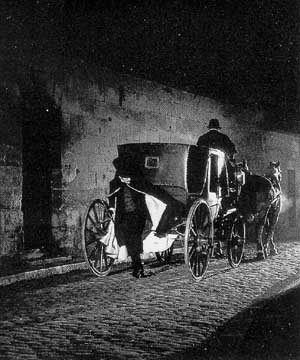


[The
Black Coats]
"I had a strange dream last night.
I saw myself a hundred years from now,
speaking to a man whose father has not yet been born
but who was already wearing a grey beard,
and telling him that there are only two things that shall not die:
God, who is GOOD,
and I, who is EVIL."
(The Colonel - Maman Leo
- Chapter XLI)

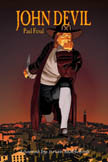
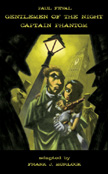
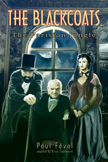

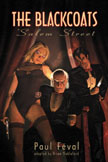

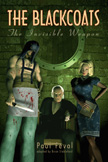


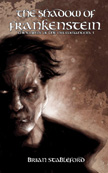
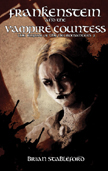
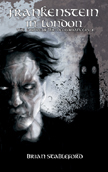

TO FIND OUT MORE, BUY THESE BOOKS
Created & Written by: Paul Féval (1816-1887)
 Paul
Féval, like Alexandre Dumas, was the author of numerous popular swashbuckling
novels, such as Le Loup Blanc (The White Wolf) (1843), a pre-Count of Monte-Cristo-like
tale, and the perennial best-seller Le Bossu
(The Hunchback) (1857), in which the hero,
the Chevalier de Lagardère, a prodigious
swordsman, disguises himself as a hunchback to take revenge against his enemies. Le
Bossu has been the subject of half-a-dozen feature film adaptations (the last one made in 1997),
various sequels, etc.
Paul
Féval, like Alexandre Dumas, was the author of numerous popular swashbuckling
novels, such as Le Loup Blanc (The White Wolf) (1843), a pre-Count of Monte-Cristo-like
tale, and the perennial best-seller Le Bossu
(The Hunchback) (1857), in which the hero,
the Chevalier de Lagardère, a prodigious
swordsman, disguises himself as a hunchback to take revenge against his enemies. Le
Bossu has been the subject of half-a-dozen feature film adaptations (the last one made in 1997),
various sequels, etc.
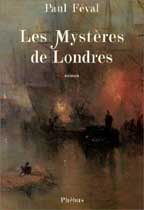 Féval's first best-seller, Les
Mystères de Londres (The Mysteries
of London) (1844) was crafted as an attempt to cash in on Eugene Sue's best-selling Les
Mystères de Paris (1842-43), which featured the avenging Prince Rodolphe of Gerolstein. The book starts between
1810 and 1820, when young Irishman Fergus O'Breane,
whose family was destroyed by the British, swears revenge. He is arrested after a duel and deported to Autralia.
He escapes and becomes a pirate, travelling to China, India, the Americas, and even meeting an exiled Napoleon
in Saint-Helens. Fergus returns to London twenty years later as a wealthy Portuguese nobleman, the Marquis de Rio Santo, socialite by day, leader of the
criminal empire of the Gentlemen of the Night
by night.
Féval's first best-seller, Les
Mystères de Londres (The Mysteries
of London) (1844) was crafted as an attempt to cash in on Eugene Sue's best-selling Les
Mystères de Paris (1842-43), which featured the avenging Prince Rodolphe of Gerolstein. The book starts between
1810 and 1820, when young Irishman Fergus O'Breane,
whose family was destroyed by the British, swears revenge. He is arrested after a duel and deported to Autralia.
He escapes and becomes a pirate, travelling to China, India, the Americas, and even meeting an exiled Napoleon
in Saint-Helens. Fergus returns to London twenty years later as a wealthy Portuguese nobleman, the Marquis de Rio Santo, socialite by day, leader of the
criminal empire of the Gentlemen of the Night
by night.
THE STAGE PLAY
VERSION OF MES MYSTERES DE LONDRES IS NOW AVAILABLE FROM BLACK COAT PRESS
Féval's greatest claim to fame is, undoubtedly, to be one of the fathers of the modern crime thriller. Féval
outdid both Sue and Dumas by introducing the concepts of criminal conspiracies and of the modern detective, which
later influenced Gaboriau and Conan Doyle. Féval's masterpieces are Jean Diable
(1862) and Les Habits Noirs (The Black Coats) (1863-75).
JEAN DIABLE IS NOW
AVAILABLE FROM BLACK COAT PRESS
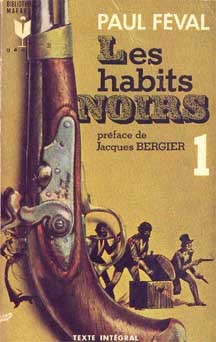 Les Habits Noirs
Les Habits Noirs
The Habits Noirs saga was written between
1863 and 1875 and is comprised of seven or eight novels depending how one counts. It was originally written to
compete against Rocambole.
In the first volume, entitled Les Habits Noirs [The Black Coats]
(1863), Féval's merely rehashes his plot for Le Bossu into a mid-19th century setting. But unlike Le Bossu, which featured a single adversary, Féval had the brilliant idea of inventing an all-powerful
international brotherhood of criminals, a 19th century Mafia, led by the mysterious Colonel
Bozzo-Corona, the Moriarty-like godfather of a criminal empire which dates
back a century. The Colonel's right-hand man is Monsieur Lecoq, also nicknamed Toulonnais L'Amitié, a character inspired by the real-life master criminal turned Prefect of Police, Vidocq, who also inspired Balzac's Vautrin, and whose "memoirs" inspired Edgar Allan Poe's Dupin.
THE PARISIAN
JUNGLE IS NOW AVAILABLE FROM BLACK COAT PRESS
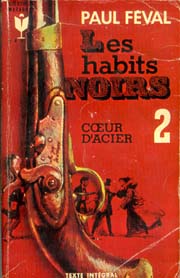 The huge success
of Les Habits Noirs prompted Féval
to write a second story, Coeur d'Acier
[Heart of Steel]
(1865), which was not a sequel, but the tale of another member of the High Council of the Habits Noirs previously
seen only in a cameo, the beautiful Marguerite Sadoulas,
a.k.a. Marguerite de Bougogne. Marguerite becomes Countess of Clare by marrying the brutish Count Joulou du Bréhut de
Clare, who is besotted with her. Marguerite plots to steal the enormous fortune
of the Clare Inheritance. The story takes place between 1832 to 1843. Marguerite's adversary are Dr. Abel Lenoir, whose brother was killed by Joulou, and
the mysterious M. Coeur (Mr. Hart), a.k.a. Coeur d'Acier
(Heart of Steel), who is later revealed to be Roland Fitz-Roy, Duke de Clare, the legitimate heir. In the end, Roland exposes and defeats Marguerite and regains his title
and wealth. Once again, Féval made the mistake of having Marguerite shot by a remorseful Joulou at the end
of the book.
The huge success
of Les Habits Noirs prompted Féval
to write a second story, Coeur d'Acier
[Heart of Steel]
(1865), which was not a sequel, but the tale of another member of the High Council of the Habits Noirs previously
seen only in a cameo, the beautiful Marguerite Sadoulas,
a.k.a. Marguerite de Bougogne. Marguerite becomes Countess of Clare by marrying the brutish Count Joulou du Bréhut de
Clare, who is besotted with her. Marguerite plots to steal the enormous fortune
of the Clare Inheritance. The story takes place between 1832 to 1843. Marguerite's adversary are Dr. Abel Lenoir, whose brother was killed by Joulou, and
the mysterious M. Coeur (Mr. Hart), a.k.a. Coeur d'Acier
(Heart of Steel), who is later revealed to be Roland Fitz-Roy, Duke de Clare, the legitimate heir. In the end, Roland exposes and defeats Marguerite and regains his title
and wealth. Once again, Féval made the mistake of having Marguerite shot by a remorseful Joulou at the end
of the book.
 The next volume
was published in 1867, and was entitled L'Avaleur de Sabre [The Sword Swallower]
(and its second half Mademoiselle Saphir).
The story takes place much later, between 1852 and 1866, and chronicles what looks like the end of the Black Coats.
In 1852, 12-year-old Saladin, son of Similor,
one of the Black Coats' henchmen and himself a future criminal, kidnaps baby Justine
de Vibraye and entrusts her to a circus of crime performer, the kind, towering
bearded lady / lion tamer Leocadie Samayoux, a.k.a. Maman Leo. By 1866, Saladin has now become the Marquis Franz de
Rosenthal, and Justine the rope dancer Miss
Sapphire. Saladin becomes the leader of the Black
Silk Hoods, a new gang formed from the remains of the Black Coats, who have
fallen prey to in-fighting after the Colonel's death. Eventually, her real father, Justin
de Vibraye, finds Justine, saves her from Saladin's clutches, and marries
her to young Hector de Sabran.
The next volume
was published in 1867, and was entitled L'Avaleur de Sabre [The Sword Swallower]
(and its second half Mademoiselle Saphir).
The story takes place much later, between 1852 and 1866, and chronicles what looks like the end of the Black Coats.
In 1852, 12-year-old Saladin, son of Similor,
one of the Black Coats' henchmen and himself a future criminal, kidnaps baby Justine
de Vibraye and entrusts her to a circus of crime performer, the kind, towering
bearded lady / lion tamer Leocadie Samayoux, a.k.a. Maman Leo. By 1866, Saladin has now become the Marquis Franz de
Rosenthal, and Justine the rope dancer Miss
Sapphire. Saladin becomes the leader of the Black
Silk Hoods, a new gang formed from the remains of the Black Coats, who have
fallen prey to in-fighting after the Colonel's death. Eventually, her real father, Justin
de Vibraye, finds Justine, saves her from Saladin's clutches, and marries
her to young Hector de Sabran.
Féval had now painted himself into a fictional corner. In order to keep exploiting the huge success of Les Habits Noirs, he had to reinvent the entire series,
which he did in the next volume, also published in 1867, and entitled La
Rue de Jerusalem [Jerusalem Street], named after the headquarters of the Sureté.
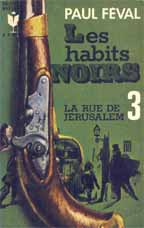 In this volume, Féval wisely went back in time to tell stories that took place before
the previous two volumes, which enabled him to re-use the charismatic Colonel, Lecoq and Marguerite of Clare again, who had all been previously
disposed of in the earlier books. The novel takes place between 1834 and 1838. In it, the Black Coats use a fake
Louis XVII, a pretender to the throne of France, to steal the fortune of Mathurine Goret of Champmas. In the end,
the Pretender betrays the Colonel, and the Black Coats' merciless executioner, Coyatier a.k.a. the Marchef (whose hand even other criminals are afraid to shake), seals him alive
inside a wall. This novel also introduces the character of Clampin, nicknamed Pistolet, a young private detective whose methods anticipate Rouletabille and Archie Goodwin.
In this volume, Féval wisely went back in time to tell stories that took place before
the previous two volumes, which enabled him to re-use the charismatic Colonel, Lecoq and Marguerite of Clare again, who had all been previously
disposed of in the earlier books. The novel takes place between 1834 and 1838. In it, the Black Coats use a fake
Louis XVII, a pretender to the throne of France, to steal the fortune of Mathurine Goret of Champmas. In the end,
the Pretender betrays the Colonel, and the Black Coats' merciless executioner, Coyatier a.k.a. the Marchef (whose hand even other criminals are afraid to shake), seals him alive
inside a wall. This novel also introduces the character of Clampin, nicknamed Pistolet, a young private detective whose methods anticipate Rouletabille and Archie Goodwin.
It is in Chapter IX of Part I of La Rue de Jerusalem
that Féval first told his readers the back story of the Habits Noirs, connecting the saga to no less than
four of his earlier novels: Les Mystères de Londres (The Mysteries of London)
(1844), Jean Diable (1862) and the historical
swashbucklers Bel Demonio (1850) and Les Compagnons du Silence [The
Companions of Silence] (1857). Until then, it can be theorized that Féval
had not yet decided to embark on a vast, historical criminal saga, to rival Balzac's Human
Comedy.
LA RUE DE JERUSALEM
IS NOW AVAILABLE FROM BLACK COAT PRESS
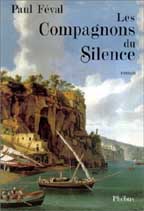 Bel Demonio opens in 1625 Sicily. Ercole Vitelli murders François
Vitelli, the legitimate heir of the wealthy Monteleone family, under the eyes
of François' son, Andréa. Ten years later, Andréa Vitelli (de Monteleone) returns
and seeks revenge as Bel Demonio, the
leader of a ring of bandits and founder of the secret conspiracy of the Brothers
of Mercy. Bel Demonio was the earliest novel written by Feval in the sequence
and can be read as a prototype for the more ambitious Les Compagnons du Silence.
Bel Demonio opens in 1625 Sicily. Ercole Vitelli murders François
Vitelli, the legitimate heir of the wealthy Monteleone family, under the eyes
of François' son, Andréa. Ten years later, Andréa Vitelli (de Monteleone) returns
and seeks revenge as Bel Demonio, the
leader of a ring of bandits and founder of the secret conspiracy of the Brothers
of Mercy. Bel Demonio was the earliest novel written by Feval in the sequence
and can be read as a prototype for the more ambitious Les Compagnons du Silence.
Les Compagnons du Silence
starts in Naples in 1801 when the Count Mario de Monteleone marries the Countess d'Amalfi.
In 1815, however, Mario joins forces with the former General Murat to overthrow Ferdinand. Both men are arrested and executed in November. In 1823, a mysterious
stranger walks into their midst, claiming to be the bandit leader Bel Demonio, now hiding under the guise of the wealthy Prince Coriolani, but in reality, he is Mario's eldest son, bent on a mission of vengeance.
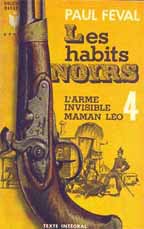 Having found his stride, Féval wrote the next two books in the series, L'Arme Invisible [The
Invisible Weapon] and Maman
Léo, which were published in 1869, and are perhaps the best in the
saga. The story takes place in 1838, just after La Rue de Jésusalem. The Black Coats are worried about young magistrate Remy
d'Arx who is investigating them. The Colonel decides to use wjat he calls
his "invisible weapon" against him. That turns out to be Fleurette, a young girl raised by Maman Leo.
Remy falls in love with Fleurette, but then discovers that she is his biological sister, and commits suicide. In
the second volume, Fleurette, Maman Leo and her friend, Echalot, strike back at the Black Coats. The Colonel suprisingly helps Fleurette save her true love,
young Maurice, who was framed by the Black
Coats and was about to be sent to the gallows. Fleurette and Maurice leave France, never to return. In a parallel
plot, the Colonel thwarts a scheme by the members of the High Council to kill him and steal his treasure.
Having found his stride, Féval wrote the next two books in the series, L'Arme Invisible [The
Invisible Weapon] and Maman
Léo, which were published in 1869, and are perhaps the best in the
saga. The story takes place in 1838, just after La Rue de Jésusalem. The Black Coats are worried about young magistrate Remy
d'Arx who is investigating them. The Colonel decides to use wjat he calls
his "invisible weapon" against him. That turns out to be Fleurette, a young girl raised by Maman Leo.
Remy falls in love with Fleurette, but then discovers that she is his biological sister, and commits suicide. In
the second volume, Fleurette, Maman Leo and her friend, Echalot, strike back at the Black Coats. The Colonel suprisingly helps Fleurette save her true love,
young Maurice, who was framed by the Black
Coats and was about to be sent to the gallows. Fleurette and Maurice leave France, never to return. In a parallel
plot, the Colonel thwarts a scheme by the members of the High Council to kill him and steal his treasure.
L'ARME INVISIBLE
IS NOW AVAILABLE FROM BLACK COAT PRESS
 The theme of the
treasure moves to center stage in the next volume, Les Compagnons
du Trésor [The Companions of the
Treasure] published in 1870, but completed only after the war in 1872. The
story begins in 1835, and ends in 1843. The so-called "Companions of the Treasure" are none other than
the members of the High Council more intent than ever on killing the Colonel and stealing his treasure. Féval
engages in a bit of retroactive continuity by going over the Colonel's death scene already decribed in the first
volume, Les Habits Noirs, and showing
us that there was, in fact, far more to it than we knew.
The theme of the
treasure moves to center stage in the next volume, Les Compagnons
du Trésor [The Companions of the
Treasure] published in 1870, but completed only after the war in 1872. The
story begins in 1835, and ends in 1843. The so-called "Companions of the Treasure" are none other than
the members of the High Council more intent than ever on killing the Colonel and stealing his treasure. Féval
engages in a bit of retroactive continuity by going over the Colonel's death scene already decribed in the first
volume, Les Habits Noirs, and showing
us that there was, in fact, far more to it than we knew.
In this book, the Colonel is apparently murdered by his own son, Count Julian, who then goes on to impersonate him, like Moriarty's younger brother impersonates the older Professor in John Gardner's series. The death scene seen in Volume 1 was therefore only an elaborate charade staged
by Julian, who has become the "new" Colonel, and appears to return from the dead in the guise of the
old Colonel thereafter. But the Colonel somehow reaches from beyond the grave and uses architect Vincent Carpentier and Reynier, Julian's son and his grand-son, to set a deadly trap in motion that kills virtually all of
the conspirators, except for Reynier and
his girl-friend Irene Carpentier.
THE COMPANIONS
OF THE TREASURE IS NOW AVAILABLE FROM BLACK COAT PRESS
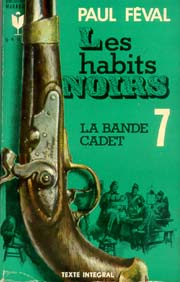
The final volume, La Bande Cadet
[The Cadet Gang] (1875) bridges the gap
between the 1843 events told in Les Compagnons du Trésor, and the 1852 events that began in L'Avaleur de Sabres. Féval continues to indulge in some retroactive continuity, revisiting the events of
Coeur d'Acier and revealing that Marguerite of Clare is still alive in 1853, ten years
after she was presumably killed at the end of that volume. The Clare fortune is now in the hands of Clotilde, who has been masquerading as the aerialist Lirette. Meanwhile, the deadly Cadet
Gang, led by Cadet L'Amour, has stepped into the vacuum created by the destruction of the High Council in the previous
volume, and now seeks the Treasure of the Black Coats. But Cadet L'Amour is thwarted by a Colonel who has once
again mysteriously returned from the grave (whether this Colonel is the real Colonel, Julian,or Reynier is unclear),
and in the end Cadet dies.
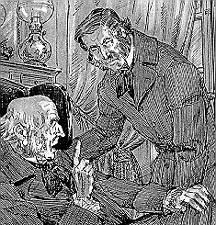 A few notes about the Habits Noirs' code words:
A few notes about the Habits Noirs' code words:
"Il fait jour" (It's daylight) means to commit a crime -- "Fera-t-il jour demain?" (Will there be daylight tomorrow?) therefore means, will
a crime be committed tomorrow? The ritual reply is "It will be daylight from midnight to noon if it's the
will of the father." Conversely, "Il fait nuit" (It's night) means that things are going badly for
the gang and that they should flee. "Coupez la branche" (cut a limb) means killing the member that is
responsible for the failure and could, if captured, betray the rest of the gang. Finally, "payer la loi"
(pay the Law) means to always frame an innocent for the crime to be committed.
By its methods, its themes and its characters, Les Habits Noirs was the precursor of today's conspiracy and organized crime novels. Paul Féval can justly claim to be one of the fathers of the modern hard-boiled crime thriller. Furthermore,
his heroes -- from Gregory Temple, the first "detective" in modern fiction, to Remy d'Arx, the investigative
magistrate -- are also the first modern heroes of their kind.
In 1862, Féval founded the magazine Jean Diable,
named after his eponymous novel, and Emile Gaboriau,
creator of Monsieur Lecoq,
was one of its editors. Gaboriau then went on to create his own Lecoq, which in turn influenced Conan Doyle's creation of Sherlock
Holmes.
 Wold Newton Universe Links:
Wold Newton Universe Links:
The behind-the-scene machinations of the Black Coats
are the secret glue that connects many of the heretofore unexplained World
Newton Universe history. The presence of several of the Black Coats' High
Council at Wold Newton, and its impact on the world's history, is explained in our article on The Conspiracy.
The life and times of two of the Black Coats' most notorious leaders are narrated in our articles on Joseph Balsamo (a.k.a. the Count
of Monte-Cristo and Captain Nemo, among others), and the notorious Lecoq family.
A genealogical tree that shows how several of the Black Coats' families have married into the lineages of other
Wold Newton families is graphically charted in our article, The
Tangled Web.
As it had long been suspected, the infamous Professor Moriarty was recently revealed to have belonged to the Black Coats -- see COMICS below.
Brian Stableford is currently writing
a sequels to JOHN DEVIL and THE BLACK COATS (which aslso draws from Paul Féval's
Revenants and The
Vampire Countess and Mary Shelley's Frankenstein) entitled The Empire of the Necromancers. Volume
1, THE SHADOW OF FRANKENSTEIN, is now available from Black Coat Press.
Finally, a modern-day successor of the Black Coats,
known as BlackSpear Holdings, has appeared
in Jean-Marc Lofficier's novel Crépuscule Vaudou (Baleine, 20008), translated and published into English as The Katrina Protocol (Black Coat Press, 2008).
BlackSpear Holdings will also feature
in an episode of the Italian comics series Martin Mystère entitled "The Treasure of the Black Coats," also written by Jean-Marc Lofficier, scheduled to be published by Bonelli in 2009.
TELEVISION
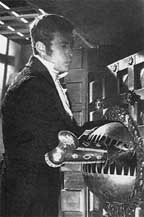 |
Les Habits Noirs
(ORTF 1, B&W., Thirty-One 15 min. episodes, 16 October - 24 November 1967)
Dir: René Lucot.
Wri: Jacques Siclier, based on the novels
by Paul Féval.
Cast: Jean-François Calvé
(Lecoq), Jean-Pierre Bernard (André Maynotte), Julia Dancourt (Julie Maynotte), Jean Lanier (Colonel Bozzo-Corona),
François Dalou (J.-B. Schwartz), Bernard Jousset, Renée Barell, Gilette Barbier, Raymond Jourdan,
Raoul Curet, Roger Jaquet, Maïa Simon, Annie Siniglia, Jean-Pierre Brunot, Jean-Pierre Leroux, Gilles Guillot.
Story: Relatively faithful adaptation
of the first volume in the series. |
THE COMICS
A brief history of the Black Coats is
told by the mysterious French crime-fighter known as John Mist (Jean Brume) in Homicron, Ep. 3, L'Ombre
du Passé (The Shadow from the Past), originally published in France in FANTASK No. 3 (Semic, June 2001) and in the US in
STRANGERS: HOMICRON. The story is by Jean-Marc Lofficier; the art by Jean-Jacques Dzialowski.
Among other things, it establishes that the Black Coats'leadership went from Bel
Demonio to Colonel Bozzo-Corona to Professor Moriarty
before eventually ending up with Rick Ross III, a WWII comic-book hero from the Hexagon Comics universe. There,
the modern-day incarnation of the Black Coats isa known as CRIMEN.
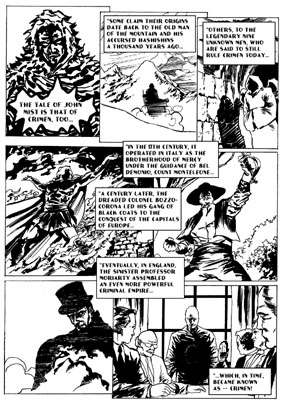
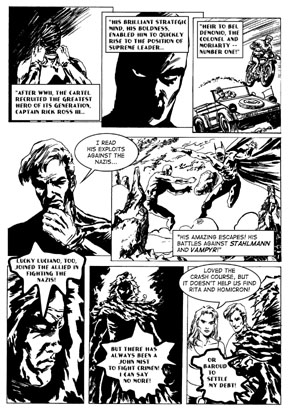


















 Paul
Féval, like Alexandre Dumas, was the author of numerous popular swashbuckling
novels, such as Le Loup Blanc (The White Wolf) (1843), a pre-Count of Monte-Cristo-like
tale, and the perennial best-seller Le Bossu
(The Hunchback) (1857), in which the hero,
the Chevalier de Lagardère, a prodigious
swordsman, disguises himself as a hunchback to take revenge against his enemies. Le
Bossu has been the subject of half-a-dozen feature film adaptations (
Paul
Féval, like Alexandre Dumas, was the author of numerous popular swashbuckling
novels, such as Le Loup Blanc (The White Wolf) (1843), a pre-Count of Monte-Cristo-like
tale, and the perennial best-seller Le Bossu
(The Hunchback) (1857), in which the hero,
the Chevalier de Lagardère, a prodigious
swordsman, disguises himself as a hunchback to take revenge against his enemies. Le
Bossu has been the subject of half-a-dozen feature film adaptations ( Féval's first best-seller, Les
Mystères de Londres (The Mysteries
of London) (1844) was crafted as an attempt to cash in on Eugene Sue's best-selling Les
Mystères de Paris (1842-43), which featured the avenging Prince Rodolphe of Gerolstein. The book starts between
1810 and 1820, when young Irishman Fergus O'Breane,
whose family was destroyed by the British, swears revenge. He is arrested after a duel and deported to Autralia.
He escapes and becomes a pirate, travelling to China, India, the Americas, and even meeting an exiled Napoleon
in Saint-Helens. Fergus returns to London twenty years later as a wealthy Portuguese nobleman, the Marquis de Rio Santo, socialite by day, leader of the
criminal empire of the Gentlemen of the Night
by night.
Féval's first best-seller, Les
Mystères de Londres (The Mysteries
of London) (1844) was crafted as an attempt to cash in on Eugene Sue's best-selling Les
Mystères de Paris (1842-43), which featured the avenging Prince Rodolphe of Gerolstein. The book starts between
1810 and 1820, when young Irishman Fergus O'Breane,
whose family was destroyed by the British, swears revenge. He is arrested after a duel and deported to Autralia.
He escapes and becomes a pirate, travelling to China, India, the Americas, and even meeting an exiled Napoleon
in Saint-Helens. Fergus returns to London twenty years later as a wealthy Portuguese nobleman, the Marquis de Rio Santo, socialite by day, leader of the
criminal empire of the Gentlemen of the Night
by night.  Les Habits Noirs
Les Habits Noirs The huge success
of Les Habits Noirs prompted Féval
to write a second story, Coeur d'Acier
[Heart of Steel]
(1865), which was not a sequel, but the tale of another member of the High Council of the Habits Noirs previously
seen only in a cameo, the beautiful Marguerite Sadoulas,
a.k.a. Marguerite de Bougogne. Marguerite becomes Countess of Clare by marrying the brutish Count Joulou du Bréhut de
Clare, who is besotted with her. Marguerite plots to steal the enormous fortune
of the Clare Inheritance. The story takes place between 1832 to 1843. Marguerite's adversary are Dr. Abel Lenoir, whose brother was killed by Joulou, and
the mysterious M. Coeur (Mr. Hart), a.k.a. Coeur d'Acier
(Heart of Steel), who is later revealed to be Roland Fitz-Roy, Duke de Clare, the legitimate heir. In the end, Roland exposes and defeats Marguerite and regains his title
and wealth. Once again, Féval made the mistake of having Marguerite shot by a remorseful Joulou at the end
of the book.
The huge success
of Les Habits Noirs prompted Féval
to write a second story, Coeur d'Acier
[Heart of Steel]
(1865), which was not a sequel, but the tale of another member of the High Council of the Habits Noirs previously
seen only in a cameo, the beautiful Marguerite Sadoulas,
a.k.a. Marguerite de Bougogne. Marguerite becomes Countess of Clare by marrying the brutish Count Joulou du Bréhut de
Clare, who is besotted with her. Marguerite plots to steal the enormous fortune
of the Clare Inheritance. The story takes place between 1832 to 1843. Marguerite's adversary are Dr. Abel Lenoir, whose brother was killed by Joulou, and
the mysterious M. Coeur (Mr. Hart), a.k.a. Coeur d'Acier
(Heart of Steel), who is later revealed to be Roland Fitz-Roy, Duke de Clare, the legitimate heir. In the end, Roland exposes and defeats Marguerite and regains his title
and wealth. Once again, Féval made the mistake of having Marguerite shot by a remorseful Joulou at the end
of the book.  The next volume
was published in 1867, and was entitled L'Avaleur de Sabre [The Sword Swallower]
(and its second half Mademoiselle Saphir).
The story takes place much later, between 1852 and 1866, and chronicles what looks like the end of the Black Coats.
In 1852, 12-year-old Saladin, son of Similor,
one of the Black Coats' henchmen and himself a future criminal, kidnaps baby Justine
de Vibraye and entrusts her to a circus of crime performer, the kind, towering
bearded lady / lion tamer Leocadie Samayoux, a.k.a. Maman Leo. By 1866, Saladin has now become the Marquis Franz de
Rosenthal, and Justine the rope dancer Miss
Sapphire. Saladin becomes the leader of the Black
Silk Hoods, a new gang formed from the remains of the Black Coats, who have
fallen prey to in-fighting after the Colonel's death. Eventually, her real father, Justin
de Vibraye, finds Justine, saves her from Saladin's clutches, and marries
her to young Hector de Sabran.
The next volume
was published in 1867, and was entitled L'Avaleur de Sabre [The Sword Swallower]
(and its second half Mademoiselle Saphir).
The story takes place much later, between 1852 and 1866, and chronicles what looks like the end of the Black Coats.
In 1852, 12-year-old Saladin, son of Similor,
one of the Black Coats' henchmen and himself a future criminal, kidnaps baby Justine
de Vibraye and entrusts her to a circus of crime performer, the kind, towering
bearded lady / lion tamer Leocadie Samayoux, a.k.a. Maman Leo. By 1866, Saladin has now become the Marquis Franz de
Rosenthal, and Justine the rope dancer Miss
Sapphire. Saladin becomes the leader of the Black
Silk Hoods, a new gang formed from the remains of the Black Coats, who have
fallen prey to in-fighting after the Colonel's death. Eventually, her real father, Justin
de Vibraye, finds Justine, saves her from Saladin's clutches, and marries
her to young Hector de Sabran.  In this volume, Féval wisely went back in time to tell stories that took place before
the previous two volumes, which enabled him to re-use the charismatic Colonel, Lecoq and Marguerite of Clare again, who had all been previously
disposed of in the earlier books. The novel takes place between 1834 and 1838. In it, the Black Coats use a fake
Louis XVII, a pretender to the throne of France, to steal the fortune of Mathurine Goret of Champmas. In the end,
the Pretender betrays the Colonel, and the Black Coats' merciless executioner, Coyatier a.k.a. the Marchef (whose hand even other criminals are afraid to shake), seals him alive
inside a wall. This novel also introduces the character of Clampin, nicknamed Pistolet, a young private detective whose methods anticipate Rouletabille and Archie Goodwin.
In this volume, Féval wisely went back in time to tell stories that took place before
the previous two volumes, which enabled him to re-use the charismatic Colonel, Lecoq and Marguerite of Clare again, who had all been previously
disposed of in the earlier books. The novel takes place between 1834 and 1838. In it, the Black Coats use a fake
Louis XVII, a pretender to the throne of France, to steal the fortune of Mathurine Goret of Champmas. In the end,
the Pretender betrays the Colonel, and the Black Coats' merciless executioner, Coyatier a.k.a. the Marchef (whose hand even other criminals are afraid to shake), seals him alive
inside a wall. This novel also introduces the character of Clampin, nicknamed Pistolet, a young private detective whose methods anticipate Rouletabille and Archie Goodwin. Bel Demonio opens in 1625 Sicily. Ercole Vitelli murders François
Vitelli, the legitimate heir of the wealthy Monteleone family, under the eyes
of François' son, Andréa. Ten years later, Andréa Vitelli (de Monteleone) returns
and seeks revenge as Bel Demonio, the
leader of a ring of bandits and founder of the secret conspiracy of the Brothers
of Mercy. Bel Demonio was the earliest novel written by Feval in the sequence
and can be read as a prototype for the more ambitious Les Compagnons du Silence.
Bel Demonio opens in 1625 Sicily. Ercole Vitelli murders François
Vitelli, the legitimate heir of the wealthy Monteleone family, under the eyes
of François' son, Andréa. Ten years later, Andréa Vitelli (de Monteleone) returns
and seeks revenge as Bel Demonio, the
leader of a ring of bandits and founder of the secret conspiracy of the Brothers
of Mercy. Bel Demonio was the earliest novel written by Feval in the sequence
and can be read as a prototype for the more ambitious Les Compagnons du Silence. Having found his stride, Féval wrote the next two books in the series, L'Arme Invisible [The
Invisible Weapon] and Maman
Léo, which were published in 1869, and are perhaps the best in the
saga. The story takes place in 1838, just after La Rue de Jésusalem. The Black Coats are worried about young magistrate Remy
d'Arx who is investigating them. The Colonel decides to use wjat he calls
his "invisible weapon" against him. That turns out to be Fleurette, a young girl raised by Maman Leo.
Remy falls in love with Fleurette, but then discovers that she is his biological sister, and commits suicide. In
the second volume, Fleurette, Maman Leo and her friend, Echalot, strike back at the Black Coats. The Colonel suprisingly helps Fleurette save her true love,
young Maurice, who was framed by the Black
Coats and was about to be sent to the gallows. Fleurette and Maurice leave France, never to return. In a parallel
plot, the Colonel thwarts a scheme by the members of the High Council to kill him and steal his treasure.
Having found his stride, Féval wrote the next two books in the series, L'Arme Invisible [The
Invisible Weapon] and Maman
Léo, which were published in 1869, and are perhaps the best in the
saga. The story takes place in 1838, just after La Rue de Jésusalem. The Black Coats are worried about young magistrate Remy
d'Arx who is investigating them. The Colonel decides to use wjat he calls
his "invisible weapon" against him. That turns out to be Fleurette, a young girl raised by Maman Leo.
Remy falls in love with Fleurette, but then discovers that she is his biological sister, and commits suicide. In
the second volume, Fleurette, Maman Leo and her friend, Echalot, strike back at the Black Coats. The Colonel suprisingly helps Fleurette save her true love,
young Maurice, who was framed by the Black
Coats and was about to be sent to the gallows. Fleurette and Maurice leave France, never to return. In a parallel
plot, the Colonel thwarts a scheme by the members of the High Council to kill him and steal his treasure. The theme of the
treasure moves to center stage in the next volume, Les Compagnons
du Trésor [The Companions of the
Treasure] published in 1870, but completed only after the war in 1872. The
story begins in 1835, and ends in 1843. The so-called "Companions of the Treasure" are none other than
the members of the High Council more intent than ever on killing the Colonel and stealing his treasure. Féval
engages in a bit of retroactive continuity by going over the Colonel's death scene already decribed in the first
volume, Les Habits Noirs, and showing
us that there was, in fact, far more to it than we knew.
The theme of the
treasure moves to center stage in the next volume, Les Compagnons
du Trésor [The Companions of the
Treasure] published in 1870, but completed only after the war in 1872. The
story begins in 1835, and ends in 1843. The so-called "Companions of the Treasure" are none other than
the members of the High Council more intent than ever on killing the Colonel and stealing his treasure. Féval
engages in a bit of retroactive continuity by going over the Colonel's death scene already decribed in the first
volume, Les Habits Noirs, and showing
us that there was, in fact, far more to it than we knew.
 A few notes about the Habits Noirs' code words:
A few notes about the Habits Noirs' code words: Wold Newton Universe Links:
Wold Newton Universe Links:



